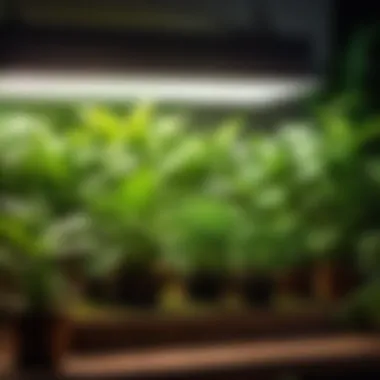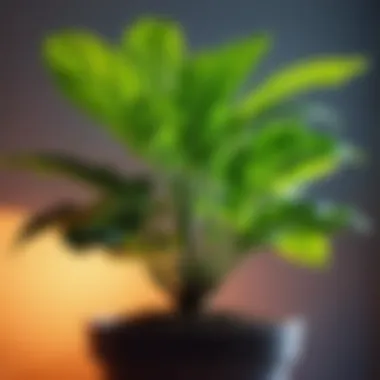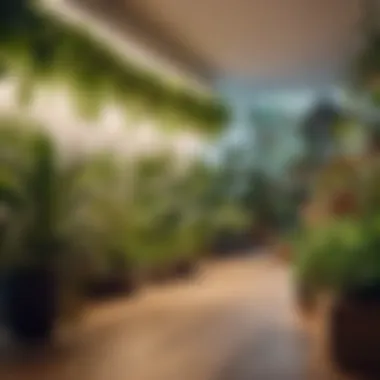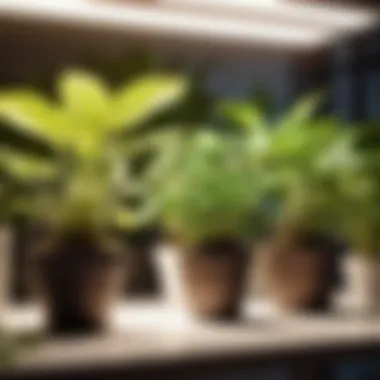Unlocking the Secrets of Optimal Indoor Plant Growth with the Best Grow Lights


Materials:
- LED grow light panel - 24" x 36"
- Adjustable hanging ropes - set of 4
- Light timer with programmable settings
- Measuring tape
- Plant-friendly nutrient-rich soil mix - 10 lbs
- Power strip with surge protection
- Watering can
DIY Steps:
- Begin by measuring the area where you will place the grow lights to ensure proper coverage.
- Install the adjustable hanging ropes securely on the ceiling, ensuring the grow light panel will hang at an optimal distance from your plants.
- Attach the LED grow light panel to the hanging ropes, making sure it is level and stable.
- Connect the light timer to the grow light panel, set the desired on/off schedule to mimic natural sunlight cycles.
- Position your indoor plants beneath the grow light, adjusting the height as needed to optimize light exposure.
- Fill plant pots with the nutrient-rich soil mix, transplanting your plants if necessary.
- Place the power strip with surge protection nearby for easy accessibility.
- Fill the watering can with water, ready for regular plant maintenance.
Technical Aspects:
- Tools: Screwdriver, scissors
- Timing: Approximately 30 minutes for setup
- Critical Techniques: Ensuring proper distance between grow lights and plants, monitoring light intensity
DIY Project Process:
Once all materials and setup are ready, proceed to hang the grow lights and adjust settings accordingly to promote healthy plant growth. Monitor plant growth progress regularly and make necessary adjustments in positioning or light schedules. Troubleshooting Tips: If plants show signs of overexposure to light (yellowing leaves), reduce light intensity or adjust hanging height; if growth is slow, consider increasing light exposure duration or nutrient levels in the soil mix.
Introduction
Indoor gardening has become increasingly popular among housewives and homeowners who seek to bring a touch of nature into their homes. In this comprehensive guide on optimal grow lights for indoor plants, we delve deep into the crucial aspect of selecting the best grow lights to ensure optimal plant growth. From understanding the importance of grow lights to exploring different types and factors to consider, this article aims to provide a detailed roadmap for achieving successful indoor gardening.
Understanding the Importance of Grow Lights
Impact of Lighting on Plant Growth
When it comes to indoor plants, lighting plays a vital role in their growth and development. The proper light spectrum ensures that plants receive the necessary energy for photosynthesis, promoting healthy growth and blooming. Understanding the impact of lighting on plant growth allows housewives and homeowners to mimic natural sunlight conditions, fostering robust plant health and vitality. The unique feature of tailored grow lights lies in their ability to provide specific light wavelengths that cater to different plant needs, enhancing their overall growth potential.
Why Indoor Plants Require Grow Lights
Indoor plants require grow lights because natural light indoors may not always be sufficient to meet their needs. Grow lights supplement natural sunlight, especially in spaces with limited light exposure. The key characteristic of grow lights is their versatility, allowing users to control both the intensity and duration of light, catering to various plant species' specific requirements. The unique feature of grow lights lies in their ability to provide a consistent light source, promoting steady growth even in environments with fluctuating natural light conditions.
Types of Grow Lights
Fluorescent Grow Lights
Fluorescent grow lights are renowned for their energy efficiency and affordability, making them a popular choice among indoor gardeners. Their key characteristic lies in their ability to emit cool, bright light that supports vegetative growth in plants. However, their unique feature of lower light intensity compared to other options may require closer positioning to plants, potentially limiting their coverage area.


LED Grow Lights
LED grow lights have gained popularity for their energy efficiency and customizable light spectrum. Their key characteristic lies in their longevity and low power consumption, making them a sustainable choice for indoor plant cultivation. The unique feature of LED grow lights is their ability to emit specific wavelengths tailored to plant needs, ensuring optimal growth while minimizing energy costs.
High-Intensity Discharge (HID) Lights
HID lights are known for their high light intensity, making them ideal for flowering plants that require intense light exposure. Their key characteristic lies in their ability to provide strong light penetration, promoting deep photosynthesis in plants. However, the unique feature of HID lights also includes higher heat emission, which may necessitate adequate ventilation to prevent heat damage to plants.
Factors to Consider
Light Spectrum
Choosing the right light spectrum is crucial for indoor plant growth as different spectrums cater to various stages of plant development. The key characteristic of light spectrum selection is matching it to the plant's growth phase, whether vegetative or flowering, to promote optimal photosynthesis and maturity. Understanding the unique feature of each light spectrum allows housewives and homeowners to provide tailored lighting solutions that meet their plants' specific needs while maximizing growth potential.
Light Intensity
Light intensity directly impacts plant growth by influencing photosynthesis rates and nutrient absorption. The key characteristic of light intensity selection is finding the right balance that meets plant requirements without causing light stress. Understanding the unique feature of adjusting light intensity helps ensure healthy plant development and prevents issues such as leaf burning or stunted growth.
Energy Efficiency
Considering energy efficiency is essential when choosing grow lights to minimize operational costs and environmental impact. The key characteristic of energy-efficient lights is their ability to convert electricity into usable light with minimal heat waste. Understanding the unique feature of energy-efficient options allows housewives and homeowners to optimize their indoor gardening setup while reducing electricity expenses.
Cost Considerations
Cost considerations are an important factor in selecting grow lights, as different types come with varying price points and operational expenses. The key characteristic of cost considerations is balancing initial investment with long-term benefits such as energy savings and durability. Understanding the unique feature of cost-effective options ensures that housewives and homeowners make informed choices that align with their budget and gardening goals.
Choosing the Best Grow Lights
When it comes to indoor gardening, the selection of grow lights plays a crucial role in ensuring optimal plant growth. Choosing the best grow lights for your indoor plants is essential for replicating the sunlight they would receive outdoors. Different plants have varying light requirements, and selecting the right type of grow light can make a significant difference in their overall health and productivity. Factors such as light spectrum, intensity, energy efficiency, and cost considerations need to be carefully evaluated to determine the most suitable grow lights for your specific indoor garden.
Plant-Specific Requirements
Flowering Plants
Flowering plants have unique lighting needs as they require specific light spectrums to initiate and maintain the blooming process. Providing them with the correct combination of red and blue light wavelengths can promote healthy flower development and enhance blossoming. LED grow lights are popular for flowering plants due to their customizable spectrum settings, allowing growers to tailor the lighting conditions based on their plants' requirements.


Leafy Greens
Leafy greens, such as lettuce and kale, thrive under grow lights that emit predominantly blue light. This light spectrum helps in stimulating vegetative growth, resulting in lush, green foliage that is rich in nutrients. LED grow lights are also ideal for leafy greens as they are energy-efficient and can be positioned close to the plant canopy without causing heat damage.
Herbs
Herbs generally prefer full-spectrum grow lights that closely mimic natural sunlight. This comprehensive light range supports all stages of herb growth, from seed germination to flowering. Full-spectrum LED grow lights are a popular choice for growing herbs indoors as they promote robust growth and flavorful yields.
Setting Up Grow Lights
Placement
The placement of grow lights is critical to ensure uniform light distribution to all plants in your indoor garden. Positioning the lights too close can lead to light burn, while placing them too far will result in insufficient light intensity for proper growth. Finding the optimal height and angle for light placement will depend on the specific light requirements of your plants and the type of grow lights you are using.
Duration of Light Exposure
Determining the right duration of light exposure is essential for providing plants with the appropriate amount of light energy for photosynthesis. Most indoor plants benefit from 12-16 hours of light exposure per day, with some variations based on plant species and growth stage. Using a timer system can help automate the light cycle, ensuring consistent lighting for your plants.
Light Distance from Plants
Maintaining the optimal distance between grow lights and plants is crucial to prevent light stress or deficiencies. Different types of grow lights have varying penetration capacities, affecting the required distance between the light source and the plant canopy. Adjusting the light distance as plants grow taller is vital to promote even growth and prevent overcrowding.
Top Grow Lights in the Market
Roleadro LED Grow Light
Roleadro LED grow lights are known for their energy efficiency and ability to provide plants with the necessary light spectrum for growth. These lights are suitable for a wide range of indoor plants, offering consistent performance and longevity. With adjustable brightness and light modes, Roleadro LED grow lights cater to the specific needs of various plant species.
MARS HYDRO TS 1000W LED Grow Light
MARS HYDRO TS 1000W LED grow lights are popular for their high light output and coverage area, making them ideal for larger indoor gardens. These lights have a full spectrum design that supports all stages of plant growth, from seedling to flowering. With advanced cooling systems, MARS HYDRO lights maintain optimal operating temperatures, promoting plant health.
Spider Farmer SF- LED Grow Light
Spider Farmer SF-2000 LED grow lights are renowned for their efficiency and durability, providing plants with intense light penetration for maximum growth potential. These lights feature high-quality diodes that ensure uniform light distribution and minimal light loss. The dimming and spectrum adjustability of Spider Farmer lights make them versatile for different plant types and growth stages.


Maintaining Grow Lights
Maintaining grow lights is a critical aspect that should not be overlooked when it comes to indoor gardening. Proper maintenance ensures the longevity and efficiency of your grow lights, ultimately leading to successful plant growth. By understanding the importance of regular upkeep, housewives and house owners can optimize their indoor gardening experience and reap the benefits of thriving plants.
Cleaning and Maintenance
Regular Dusting
Regular dusting plays a vital role in maintaining grow lights as it helps prevent dust buildup that can obstruct light transmission. Dust accumulation on light fixtures can reduce the light intensity reaching plants, hindering their growth potential. By incorporating regular dusting into your maintenance routine, you can ensure consistent and adequate light exposure for your indoor plants. This simple yet effective practice enhances the overall efficiency of grow lights and promotes healthier plant development.
Preventing Heat Build-Up
Preventing heat build-up is crucial for the optimal performance of grow lights and the safety of your indoor gardening setup. Overheating can not only damage the light fixtures but also pose a risk to your plants. By implementing strategies to regulate temperature and airflow around grow lights, such as proper ventilation and spacing, you can mitigate the risk of heat-related issues. Maintaining a suitable environment around your grow lights ensures a stable and conducive setting for plant growth.
Troubleshooting Common Issues
Flickering Lights
Flickering lights can be a common issue with grow lights and may indicate underlying problems that require attention. Addressing flickering lights promptly is essential to maintain consistent light output for optimal plant growth. By identifying the root cause of flickering, such as loose connections or faulty bulbs, housewives and house owners can take the necessary steps to rectify the issue and ensure uninterrupted light supply for their indoor plants.
Uneven Light Distribution
Uneven light distribution can lead to disparities in plant growth and health, affecting the overall aesthetics of your indoor garden. Achieving uniform light coverage is essential to promote equal photosynthesis across all plants and prevent shadowed areas. By adjusting the positioning of grow lights or incorporating supplementary lighting where needed, you can achieve balanced light distribution and create an environment conducive to uniform plant growth.
Conclusion
In the realm of indoor gardening, the significance of selecting the optimal grow lights cannot be overstated. As this article has extensively covered, the proper choice of grow lights is crucial in ensuring the healthy development and growth of indoor plants. By understanding the diverse types of grow lights available and considering factors such as light spectrum, intensity, energy efficiency, and cost, individuals can create an ideal environment for their plants to thrive.
Summarizing Key Points
Selection Criteria for Grow Lights
When it comes to selecting grow lights for indoor plants, one of the key aspects to consider is the light spectrum. Different plants have varying light requirements during different stages of growth, such as blue light for vegetative growth and red light for flowering. The selection criteria for grow lights should therefore focus on providing the appropriate spectrum to meet the specific needs of the plants being cultivated.
LED grow lights, known for their energy efficiency and customizable spectrum options, have become a popular choice for indoor gardening enthusiasts. Their ability to mimic natural sunlight and adjust to different plant growth phases make them a versatile and beneficial option for creating optimal lighting conditions for indoor plants. While LED lights may have a higher initial cost than traditional fluorescent lights, their long-term advantages in energy savings and plant growth make them a valuable investment for indoor gardeners.
Benefits of Optimal Lighting for Indoor Plants
Optimal lighting plays a fundamental role in the overall health and productivity of indoor plants. By providing the right spectrum and intensity of light, plants are able to carry out essential processes such as photosynthesis effectively, leading to robust growth, vibrant foliage, and bountiful blooms. Additionally, optimal lighting helps plants regulate their growth patterns, resulting in healthier and more resilient specimens.
LED grow lights, in particular, offer the benefit of low heat emissions, reducing the risk of heat stress for plants and creating a comfortable environment for optimal growth. Their flexibility in color temperatures and intensity levels allows for customized light settings that cater to the specific needs of various plant species. Overall, the benefits of optimal lighting for indoor plants extend beyond mere illumination, impacting the overall well-being and flourishing of indoor greenery.







